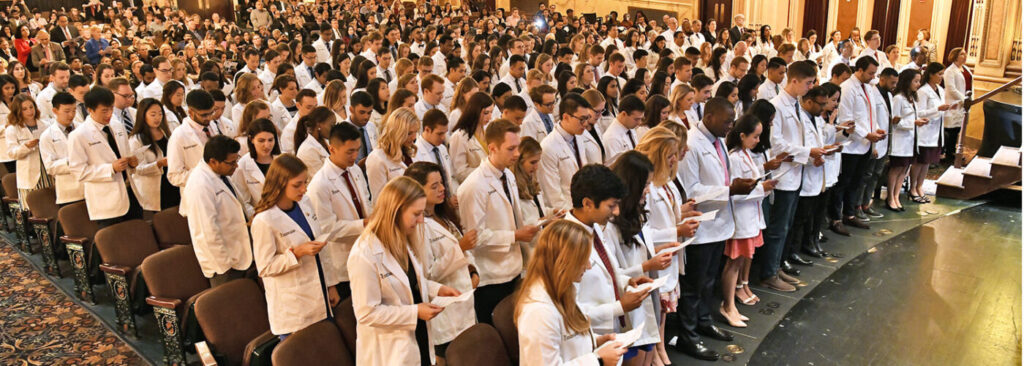The University of Maryland School of Medicine was the first public medical school in the U.S., the first university to build a teaching hospital, and the first to offer residency programs. Faculty and alumni have accomplished historic surgical feats and made numerous important breakthroughs in the study of infectious diseases such as COVID-19, Ebola, and influenza.
What does it take to get into Maryland Medical School? We’ve organized everything you need to know about the school to craft an effective application. Consider bookmarking this page for easy reference during your application process.
Be an Informed Applicant
Every year, UMSOM receives thousands of applications, yet only a few hundred candidates are offered acceptances.
The truth is, there’s a lot more than academic requirements to keep in mind when applying to UMSOM. We recommend using this guide to familiarize yourself with the school’s history, institutional identity, curriculum, and current teaching methods. By taking to the time to do some preparatory research, you’ll have a competitive edge when it comes time to apply.
This article covers:
- Maryland Medical School’s Rankings and Institutional Identity (Why UMSOM?)
- Medical Programs at the University of Maryland School of Medicine
- University of Maryland Medical School Requirements (GPA, MCAT Scores, Required Coursework)
- University of Maryland Medical School Acceptance Rate, Class Profile, and Other Admissions Statistics
- UMSOM Tuition and Cost of Attendance
- AMCAS Primary Application and UMSOM Medical School Secondary Application
- Maryland School of Medicine Secondary Application: Essay Prompts, Sample Answers, and Advice
- Medical School Admissions Consulting
- Healthcare Internships: Physician Shadowing Abroad
Personalized Help
Applying to medical schools takes time, organization, and focus. We publish a variety of helpful guides for future medical students. Still, personalized help is only a click away. Our medical school admissions consulting offers guidance throughout your entire application process and leverages decades of experience and expertise to optimize your candidacy.
Why University of Maryland School of Medicine?
The Maryland School of Medicine is a well-funded, highly ranked university with a rich history in medical education. It’s in the top 10 most productive public research institutions in the country, has over 30 treatment facilities around the world, and houses an enormous amount of top-tier departments, institutes, and medical and research centers.
UMSOM is recognized as a leader in translational medicine and boasts 358 granted patents and over 30 start-up companies. The school offers exceptional research-oriented dual degree programs, ranks in the top 30 best medical schools for research, and has received $563 million in extramural funding.
The school has recently introduced a new “Renaissance Curriculum” that includes more extensive patient interaction, deep longitudinal learning, and a new focus on encouraging students to explore their interests early in their academic careers. Additionally, UMSOM recently employed its Culture Transformation Initiative, which introduces a clear strategy to tackle disruptive behaviors, microaggressions/workplace tensions, and unconscious bias in its medical school and healthcare institutions.
Overall, attending UMSOM is an excellent opportunity for students interested in research, clinical care, or a combination of both.
UMSOM School Rankings 2022
The University of Maryland ranks #20 in Top Public Universities and #59 in National Universities. The School of Medicine ranks:
- #27 in Best Medical Schools: Research
- #16 in Best Medical Schools: Primary Care
- #60 in Public Health
- #86 in Most Diverse Medical Schools
- #95 in Most Graduates Practicing in Medically Underserved Areas
MD Programs at Maryland Medical School
Here are the MD programs available at the University of Maryland School of Medicine:
- Doctor of Medicine (Traditional 4-year MD)
- Medical Scientist Training Program (MD/PhD)
- MD/Master of Public Health (MD/MPH)
- MD/Master in Clinical Research (MD/MSCR)
- MD/Master in Cellular & Molecular Biomedical Science (MD/MS CMBS)
- MD/Master in Bioengineering (MD/MS BIOE)
- MD/Master in Health Administration (MD/MHA)
- MD/Master in Public Policy (MD/MPP)
- MD/Master in Business Administration (MD/MBA)
4-Year MD Program
In 2020, the University of Maryland School of Medicine introduced its “Renaissance Curriculum.” The school states the goal of the new curriculum is to “Actualize the Renaissance Physician; life-long learners who are clinically excellent and possess humanism, professionalism, scholarship, leadership, critical thinking and attention to social justice and diversity.”
The new curriculum consists of four major adjustments:
- Integration and optimization of the pre-clerkship curriculum – Students are taught normal and abnormal processes simultaneously and have earlier and longer patient-focused experiences. This change also gets students into clerkships more quickly to allow them more time to explore career options.
- Improved longitudinal experiences – Courses such as Practice of Medicine and Service Learning have been extended and better integrated longitudinally across the curriculum. Other topics such as cultural competency, patient safety, and the business of medicine are now revisited throughout the curriculum.
- Improved Clerkship and Advanced Clinical phase – The Clerkship Phase has been expanded. Additionally, required clerkships have been streamlined. This allows MD students to have more versatile schedules and further explore preferred specialties.
- Educational Innovation – The Renaissance Curriculum employs a greater variety of teaching methods, such as interactive teaching and self-directed learning. The school also changed its grading system to Honors, High Pass, and Pass for the entirety of the MD program.
Here’s a more detailed rundown of the school’s new curriculum.
Year 1: Preclerkship Phase
The first year contains the following courses:
- Introduction to Medical School
- Foundations
- Blood and Host Defense
- Brain and Behavior
- Digestion and Hormones
Practice of Medicine, Foundations of Research and Critical Thinking, and Tracks and Electives are taken throughout the entirety of year 1.
Summer Break Research begins in May.
Year 2: Preclerkship Phase, USMLE, and Clerkships
Summer Break Research continues until August of year 2. Then:
- Review of First Year
- Cardiovascular, Renal, and Pulmonary
- Skin, Bones, and Musculature
- Life Cycle
- Multisystem
Practice of Medicine, Foundations of Research and Critical Thinking, and Tracks and Electives are taken throughout year 2, until March.
Clerkship Preparation and USMLE STEP 1 Preparation and Exam are taken consecutively beginning in March and ending in May.
Students begin clerkships in the summer of year 2.
Years 3 and 4: Clerkships, Sub-Internships, and Electives
In the final years of medical school, students will attend clerkships in the following fields: Pediatrics, Family Medicine, Psychiatry, Obstetrics and Gynecology, Anesthesia, Neurology, Surgery, and Emergency Medicine.
Electives and sub-internships are also completed in the final 2 years. Practice of Medicine and Back to Basics are taken in the final year and are tailored to each student’s career path.
MD/PhD and Dual Degrees
The University of Maryland School of Medicine attracts many MD students with the prospect of attending one of its many dual degree programs. The school also offers an MSTP path for students aspiring to be physician-scientists.
Medical Scientist Training Program (MD/PhD)
Students with an MD/PhD from UMSOM are equipped with the skills and training necessary to conduct biomedical research for use in clinical practice. In collaboration with the Graduate Program in Life Sciences, UMSOM offers the following MD/PhD programs:
-Biochemistry and Molecular Biology
-Bioengineering (at UMCP)
-Epidemiology and Human Genetics
-Molecular Microbiology & Immunology
-Molecular Medicine
-Neuroscience
MD/Master of Public Health (MD/MPH)
This program teaches students how to diagnose, analyze, and prevent disease and public health concerns among populations. Alumni combine clinical work with research, policy development/advocacy, and public health administration.
The MD/MPH dual degree takes 5 years to complete.
MD/Master in Clinical Research (MD/MSCR)
This dual degree instructs medical students on the methods necessary to conduct exceptional clinical research, analyze findings, and identify areas in need of research. Students are also taught how to solicit and acquire funding for clinical investigations from external sources.
The MD/MSCR takes 5 years to complete.
MD/Master in Cellular & Molecular Biomedical Science (MD/MS CMBS)
The Office of Student Research describes this multi-faceted program as one that “focuses on basic/translational research and combines traditional areas of biomedical study, including molecular and cell biology, neuroscience, pharmacology, physiology, cancer biology, and genomics into a unique interdisciplinary graduate training program.”
The MD/MS CMBS takes 5 years to complete.
MD/Master in Bioengineering (MD/MS BIOE)
This dual degree is offered in collaboration with the A. James Clark School of Engineering’s Fischell Department of Bioengineering at the University of Maryland College Park (UMCP). The program prepares students for research on topics such as biomaterials and tissue engineering, biomedical device development, biomedical imaging, and more.
The Fischell Department of Bioengineering invites students with science or engineering bachelor’s degrees to apply (those without will be evaluated on a case-by-case basis). The program takes 5 years to complete.
MD/Master in Health Administration (MD/MHA)
This program is offered in collaboration with the University of Maryland School of Public Health. Students are trained in the art of management and are prepared to administer a variety of medical institutions, such as hospitals, public health clinics, federal and state agencies, and more.
The program takes 5 years to complete.
MD/Master in Public Policy (MD/MPP)
The MPP portion of this dual degree is awarded by the University of Maryland, Baltimore County. Students undergo a thorough study of health policy, including how to evaluate a population’s needs and how public policy affects a community’s health.
MD/Master in Business Administration (MD/MBA)
The MD/MBA program teaches students how to apply business principles to the field of medicine and prepares students for careers in hospital management, family practice, and more. This is a 5-year program.
University of Maryland Medical School Requirements
GPA and MCAT Score
There is no minimum GPA or MCAT score required to receive the secondary application from Maryland Medical School. However, academic excellence is expected. The average GPA among the 2021 entering class was 3.72 in science and 3.79 overall, and the average MCAT score was 513.
MCAT scores are valid for 3 years. If you’ve taken the MCAT multiple times, the best score will be considered. However, the UMSOM admissions committee states the more times you take the MCAT (beyond 2 times), the less competitive your application will be.
Required Coursework
The admissions committee at the University of Maryland School of Medicine bases its prerequisite coursework on the AAMC Core Competencies for Entering Medical Students. Students who achieve the basic science coursework through Advanced Placement Credits are advised to complete higher-level science coursework. Prerequisite coursework must have been completed no longer than 5 years before applying.
The following coursework is required:
- Biological Sciences – one year with laboratory
- Chemical Sciences (general/inorganic) – one year with laboratory
- Organic Chemistry – either one year with laboratory or one semester of organic chemistry (with lab) and one semester of Biochemistry (lab encouraged but not required)
- Physical Sciences – one year with laboratory
- English or other writing intensive course – one year
Additionally, admissions strongly recommends these courses:
- Immunology – one semester
- Biochemistry – one semester with laboratory (lab encouraged but not required)
- Physiology – one semester
- Microbiology – one semester
- Genetics – one semester
- Epidemiology – one semester
Clinical Experience Requirements
The Admissions Committee requires that you have experience observing doctor-patient interaction through shadowing, scribing, and/or interpreting.
International Medical Aid provides exceptional internships for pre-med students, which focus on shadowing physicians abroad.
Letters of Recommendation
The admissions committee at UMSOM gives special weight to letters of recommendation. The letters you submit, in combination with compelling healthcare experience, will offset any academic imperfections that appear on your transcript.
According to UMSOM’s admissions page, “Applicants to the School of Medicine should seek out letters of recommendation from individuals who have both personal knowledge of the applicant’s accomplishments and the insight to objectively assess the applicant’s character, work ethic and motivation for a career in medicine.”
The requirements for letters of recommendation requirements at the Maryland School of Medicine are as follows:
- If your undergraduate institution has a Premedical Advisory Committee, you are required to submit a letter from this committee or your Premedical Advisor. If you are unable to submit this official letter of recommendation, you or your premed advisor/committee must write to admissions explaining why this is so.
- If your undergraduate institution doesn’t have a Premedical Advisory Committee, you must provide letters from 3 school faculty. At least 2 must be written by faculty in a science department.
- All letters must be submitted through AMCAS.
- If you’re not currently enrolled in school, you must submit at least 1 letter for each component of your education (undergrad, graduate, work, etc.).
- Exceptions are considered via written requests submitted to the Admissions Committee.
- If you are reapplying, admissions strongly recommends you send letters that are as up-to-date as possible.
Admissions Statistics: University of Maryland Medical School Acceptance Rate, Class Profile, Etc.
Out of 6,244 applicants during the 2021-2022 application cycle, 492 were interviewed and 259 were accepted. A total of 170 new students enrolled in the School of Medicine.
Here are the resident to non-resident admissions statistics:
- Total Applications: 1159 Residents, 4808 Non-Residents
- Applicants Interviewed: 247 Residents, 239 Non-Residents
- Acceptances Offered: 180 Residents, 79 Non-Residents
- New Entrants: 84% Resident, 16% Non-Resident
Of the entering class, 31% were underrepresented in medicine, 62% were students of color, and 10% were LGBTQ+.
The average GPA among the entering class was 3.72 in science and 3.79 overall. The average MCAT score was 513.
The acceptance rate for the MD, MD/PhD, and dual degree programs is 4.15%. The Maryland School of Medicine typically has an overall acceptance rate of 6-7%.
UMSOM Tuition and Cost of Attendance
Here is the cost to attend the MD program at the University of Maryland School of Medicine. Fee and tuition amounts are accurate as of the 2021-2022 application cycle and apply to full-time students. Other costs are estimates provided by the university.
For residents, the total cost of attendance is $79,141. For non-residents, the total cost of attendance is $110,723.
Here’s a breakdown of the numbers. The resident cost is listed first, followed by the non-resident cost.
Tuition: $37,810/$66,905
Mandatory Fees: $1,956/$1,956
Books: $1,380/$1,380
Health Insurance: $3,511/$3,511
Malpractice Insurance: $260/$260
Anatomy Fee: $250/$250
Living Expenses: $26,500/$26,500
Commuting Expenses: $0/$1,200
Transportation: $2,000/$2,000
Computer: $2,500/$2,500
Instruments: $750/$750
Uniforms: $60/$60
Immunizations: $170/$170
Loan Fees: $1,994/$3,281

AMCAS Primary Application and University of Maryland School of Medicine Secondary Application
The American Medical College Application Service (AMCAS) primary application is the first application you are required to submit when applying to medical schools. (Texas state schools use the TMDSAS instead of the AMCAS.)
Your AMCAS application is sent to each school you apply to. Upon receiving your primary application, UMSOM will send you an invitation to submit the secondary application.
If you still have questions, we’re here to help you understand the differences between primary and secondary medical school applications.
UMSOM Secondary Application: Essay Prompts, Sample Answers, and More
The Admissions Committee at UMSOM conducts a holistic review of your application. This means your essay answers are crucial to crafting a compelling application. While academic excellence is important to your candidacy, how you present your experiences, principles, aspirations, and knowledge of healthcare will ultimately demonstrate if you are a good fit for UMSOM.
Here are the essay prompts from the 2021-2022 application cycle. We’ve included advice for how to approach each prompt as well as some sample answers.
Only some of the questions have character limits given (1500 characters). We advise sticking to around 1500 characters for the questions without character limits and making sure to provide valuable information for each question. The Admissions Committee at UMSOM receives thousands of applications, so avoid taking up space repeating things from your AMCAS or other responses.
Essay #1
Please let us know if you have a specific reason you are interested in attending the University of Maryland School of Medicine, and/or if you have any special ties to our institution.
Medical Schools are fully aware that candidates apply to many different schools. Here, admissions wants to know if there is something specific about UMSOM that has led you to apply. While this guide contains a wealth of information about UMSOM, restating information about the school is no substitute for conveying genuine interest.
Reading back over this guide, what excites you? What stands out? Here are some things about UMSOM that could be exciting to medical school applicants:
- A newly renovated curriculum. While all medical schools revamp their curriculum, from time to time, UMSOM’s new “Renaissance Curriculum” was just introduced in 2020. The early interactions with patients, extended clerkship phase, and emphasis on interactive teaching and self-directed study make for a very contemporary approach to teaching medicine.
- Intriguing dual degrees. From bioengineering to public health, UMSOM has 7 dual degrees that can be completed in 5 years. Are any of these a “perfect fit” for your career goals?
- Exceptional focus on transforming medical culture. UMSOM isn’t alone in taking prejudice and systemic barriers in medicine seriously. Through actions such as the Culture Transformation Initiative, however, UMSOM demonstrates an exceptional ability to communicate clear strategies and goals for making progress.
- Specific programs/faculty. You should go into anything that excites you about working with a specific faculty member or attending a certain program.
Feel free to discuss any ties you have to the school or location. The focus of your answer, however, should be on what specifically has drawn you to UMSOM as a medical and educational institution.
Essay #2
Please describe and explain below any academic problems which you might have had while in college and/or graduate or professional school. Please include withdrawals, in-completes, poor grades, etc. (If you feel that you have not had any academic problems please state that)
This is an opportunity to discuss any less-than-ideal academic performances that appear on your transcript or AMCAS (although you aren’t limited to those). If multiple academic problems appear on your application, make sure to address each of them, as admissions will be aware of them.
If you’re happy with your academic track record, you can still describe a challenging academic experience.
When answering this prompt, include the circumstances that led to the academic problem, how you coped with it, and what you learned. You could include:
- Efforts you made to amend the problem
- What has changed since the issue occurred/why the issue will not be reoccurring
- What you learned about yourself, academics, and/or medicine by experiencing the failure or hardship
- How you would handle the situation differently
Try to end your response on a positive note. If you’re someone who grows from adversity, these problems will have ultimately made you a stronger candidate.
Essay #3
If a specific medical school application activity was impacted by the COVID-19 outbreak, please describe the activity, the time period during which it was to take place, and any relevant contact information.
If COVID-19 disrupted your academic and/or professional journey, this is an opportunity to explain how the pandemic has impacted your ability to participate in various medical school application activities. Explaining how you worked to mitigate these setbacks will demonstrate perseverance and resourcefulness. COVID-19 had a wide range of effects on people’s lives, but try to keep your responses limited to what the prompt is asking. Although you are free to include personal challenges, try to focus on school and healthcare-related disruptions.
Essay #4
Please explain what you will be doing during the 2021-2022 academic year. If you graduated/will graduate in 2021, what are your plans during this gap year?
Admissions wants to see that you are organized, on track, and have a solid plan for your final year before medical school. There is no wrong answer to this question, as long as you can articulate how this year will help you grow as a future physician.
If you are completing a degree, explain how you will balance coursework with extracurriculars, research, and/or work. Emphasize what you hope to accomplish before matriculating, and how it fits into your overall aspiration of becoming a physician.
If you have already graduated, describe how you will be spending your time during the gap year. Some students use this time to travel, conduct research, enroll in healthcare internships, volunteer, and/or work. However you are spending your gap year, make sure to explain how it will enhance your candidacy and prepare you for a successful career in medicine.
You likely have a lot on your plate during your gap year or senior year of college. Keep your answer organized. You can make it easy to follow by structuring it narratively.
Essay #5
Briefly describe your most important exposure to clinical medicine. (1500 characters)
The Admissions Committee at UMSOM states that they take the medical experience portion of your application most seriously. As is the case with all medical schools, your healthcare experience allows admissions to gauge not only your readiness for medical school, but also your passion for doctoring and understanding of medicine.
When describing your exposure to clinical medicine, make sure to communicate the setting and your role. Highlight any patient contact you had. Make sure to discuss what you observed and how it has impacted your understanding of medicine.
Here’s a sample answer:
In 2019, I traveled to Lima, Peru to undergo an intensive healthcare internship with International Medical Aid. Over the course of 6 weeks, my appreciation of and dedication to the service of healthcare grew exponentially. I not only shadowed physicians in intense and complex settings but also participated in health camps for underserved communities, working with patients who had never seen a doctor before. This experience solidified my desire to become a physician and gave me the clinical skills and global perspective on healthcare that I believe will benefit me for years to come.
My focus during the internship was Emergency Medicine. My uncle is an EMT, and he’s been discussing his experiences with me for years. However, before the internship, I had no real exposure to the day-to-day life of an emergency physician. Though it was challenging at first just to keep up with everything going on, after the first week I was able to truly focus and learn from the situations I was immersed in.
While it would take a lot of space to describe the numerous lessons I learned during this time, there is an aspect that sticks out to me. I witnessed the focus and effectiveness of physicians who are overloaded with patients and have less-than-ideal medical equipment. I remember the moment their sense of purpose and composure began to rub off on me. These physicians have truly inspired me to never give up, no matter what the circumstance.
Essay #6
Briefly describe your most satisfying experience related to community service. (1500 characters)
A commitment to service is one of the core values that UMSOM looks for in its applicants. When describing your most satisfying experience related to community service, make sure to communicate your role and the impact of your work. Discuss what you learned from this experience and how it has impacted your understanding of medicine and/or service.
Here’s a sample answer:
In 2018, I volunteered with a neighborhood organization in my hometown of Baltimore, Maryland. I worked with a team of people from all walks of life to provide disaster relief after a severe storm caused widespread damage and power outages.
Our work was grueling, but also very gratifying. I saw first-hand that we were really making a difference in the lives of those who were affected, which is a feeling I’ve come to cherish more than anything.
I was also able to see firsthand how important it is for medical professionals to be able to work together effectively to provide the best care possible. While I mostly helped distribute food and basic medical supplies, I spent some time with a group of first responders. I helped clear roads and provided water to those who were working long hours in difficult conditions.
This experience was eye-opening for me and grounded my desire to pursue a career in medicine. I learned how to work effectively as part of a team and how crucial it is to be able to think on your feet. However, the most satisfying aspect of this experience was the sense of community that we were able to build. Despite the fact that we were all from different backgrounds, we came together to help our community heal — and many of the people we helped joined our effort almost immediately. This was a powerful reminder that, at the end of the day, we are all human and want the same things: to be safe, help others, and feel connected to something larger than ourselves.
Essay #7
Without limiting the discussion to your own identity, please describe how you envision contributing to the core values of diversity and inclusion at our School of Medicine, and in the medical profession. (1500 characters)
Fostering a safe and inclusive environment for diverse students, patients, and faculty is a task with many actionable steps. Admissions is curious about your competency of the challenges and opportunities in these areas, as well as your ability to be an active participant in promoting change. Here are some approaches you could take with this essay, depending on your personal history and identity:
- Use examples. Consider discussing a time when you had to navigate an environment that was not welcoming of your identity or the identity of others. How did you handle this situation, what did you learn from it, and how did it prepare you to be an advocate for change?
- Discuss your understanding of the challenges faced by marginalized communities in healthcare and education.
- Communicate a dedication to unlearning bias and harmful behavior. Especially if you come from a privileged background, share your perspective on the importance of constantly evaluating your own beliefs and behaviors.
- Discuss your identity and how it has informed your ability to combat prejudice or the challenges your identity presents in this area. While the prompt asks not to limit your response to a discussion of your identity, mentioning your identity and how it plays a role in your perspective isn’t forbidden.
- Discuss your perspective on the school’s Culture Transformation Initiative. UMSOM introduced this initiative to combat prejudiced behavior, microaggressions, and unconscious bias.
However you approach your answer, emphasize your ability and commitment to contribute to an inclusive environment. Use clear, practical strategies such as speaking out in unjust situations, organizing events or safe spaces for particular identities on campus, studying the adversity faced by communities other than your own, and welcoming feedback and critique.
Essay #8
What does it mean to you to enter into a profession? (1500 characters)
This is a broad question that can be answered well in many different ways. Below are some ideas to get your gears turning, but remember that this question is asking what entering into a profession means to you. Let your unique perspective and voice shine through in your response.
- A profession is a calling: it’s something you’re passionate about and can’t imagine not doing.
- A profession is a way to serve others. It’s a way to use your knowledge and training to help people when they need it most.
- A profession is a way to provide for yourself and your family. It’s a way to have stability and security in your life.
- A profession is a commitment: it’s something you’re dedicated to and will stick with no matter what.
- A profession is a way to learn and grow. It’s a way to constantly challenge yourself and learn new things.
- A profession is a community: it’s a group of people with shared values and goals.
- A profession is a responsibility: it’s something you take seriously and are accountable for.
Professionalism is an extremely important value in the medical field. No matter what perspective you take, make sure to briefly discuss the nature and importance of professionalism and how you plan to uphold it in your career. Your response should be thoughtful, well-reasoned, and reflect your personal values.
Medical School Admissions Consulting
Healthcare institutions around the world are concerned about the shortage of healthcare workers we face in future years. That’s part of the reason we put so much effort into maintaining a site full of important resources for aspiring physicians.
While our ultimate medical school guides will undoubtedly help you on your journey to medical school, it’s simply the case that nothing beats personalized admissions consulting.
We have an exceptional team of consultants with decades of experience in medicine and education available to help you every step of the way. We provide thorough application reviews, interview prep, proofreading, and more. We’ll work with you to develop an overall, individualized strategy and craft a compelling candidacy.
There’s more to learn about our services, including free 30-minute consultations. You can find out more here.
Healthcare Internships: Physician Shadowing Abroad
The UMD School of Medicine is similar to other top medical schools when it comes to healthcare experience: it’s essential to being a competitive candidate. Of course, depth and breadth play a big role — diverse and intensive hands-on experience sets you apart from other applicants. It demonstrates your dedication to learning medicine and your ability to thrive in clinical environments.
At International Medical Aid, we prepare pre-med students for medical school and beyond through our healthcare internships abroad. Our internships include experiences such as specialized didactic sessions, community engagement, and physician shadowing. We equip students with a rich, global perspective on service and healthcare, and our interns carry these lessons with them throughout their medical careers.
Good Luck to You!
We hope you find our resources to be immensely helpful during your application process. And remember, if you need guidance along the way, our team at International Medical Aid is always here for you.
Don’t forget to explore more of our ultimate medical school guides:
- Case Western Medical School
- University of North Carolina Medical School
- University of Florida Medical School
- Emory University School of Medicine
- Boston University School of Medicine
- California University of Science and Medicine
- UC San Diego Medical School
- California Northstate University College of Medicine
- Touro University of California
- CHSU College of Osteopathic Medicine
- UC Davis School of Medicine
- Harvard Medical School
- UC Riverside School of Medicine
- USC Keck School of Medicine
- UT Southwestern Medical School
- Long School of Medicine at UT Health San Antonio
- University of the Incarnate Word School of Osteopathic Medicine
- UT Austin’s Dell Medical School
- UTMB School of Medicine
- McGovern Medical School at UT Health
- Johns Hopkins School of Medicine
- McGovern Medical School at UT Health
- The University of Texas Rio Grande Valley School of Medicine
- UNT Texas College of Osteopathic Medicine
- University of Houston College of Medicine
- Texas A&M College of Medicine
- Johns Hopkins Medical School
- Baylor College of Medicine
- George Washington University School of Medicine
- Vanderbilt University School of Medicine
- St. George’s University School of Medicine
- Lake Erie College of Osteopathic Medicine (in Pennsylvania)
- Sidney Kimmel Medical College at Thomas Jefferson University
- Wake Forest University School of Medicine
- Western University of Health Sciences (in California)
- Drexel University College of Medicine
- Stritch School of Medicine at Loyola University Chicago
- Georgetown University School of Medicine
- Yale School of Medicine
- Perelman School of Medicine
- UCLA Medical School
- NYU Medical School
- Washington University School of Medicine
- Brown Medical School
We wish you all the best in your medical school journey!








